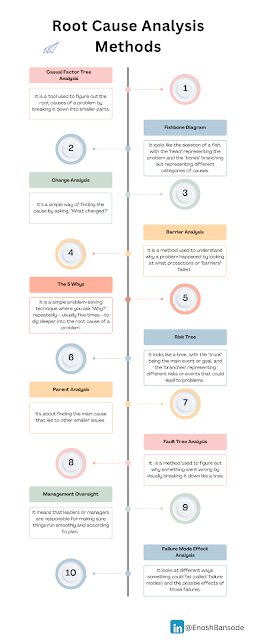Linkedin Post
1. A "casual factor tree analysis" is a tool used to figure out the root causes of a problem by breaking it down into smaller parts. Imagine it like a tree where the trunk is the main problem, and each branch represents different reasons that led to it.
2. A fishbone diagram, also known as a cause-and-effect diagram or Ishikawa diagram, is a tool used to identify the possible causes of a problem. It looks like the skeleton of a fish, with the "head" representing the problem and the "bones" branching out representing different categories of causes.
3. "Change analysis" is a method used to understand why a problem happened by looking at what changed. It compares the situation before and after the issue occurred to identify key differences.
4. Barrier analysis is a method used to understand why a problem happened by looking at what protections or "barriers" failed. Barriers are things put in place to prevent a problem, like safety measures, procedures, or equipment.
5. The 5 Whys is a simple problem-solving technique where you ask "Why?" repeatedly—usually five times—to dig deeper into the root cause of a problem.
6. A risk tree is a tool used to identify and analyze potential risks in a situation. It looks like a tree, with the "trunk" being the main event or goal, and the "branches" representing different risks or events that could lead to problems.
7. Parent analysis is a method used to trace back the cause of a problem to its "parent" or source. It's about finding the main cause that led to other smaller issues.
8. Fault tree analysis is a method used to figure out why something went wrong by visually breaking it down like a tree. The "top" of the tree represents the main problem or failure, and the branches below show all the possible causes that led to it.
9. Management oversight means that leaders or managers are responsible for making sure things run smoothly and according to plan. It involves supervising tasks, monitoring progress, and ensuring that everyone follows rules and procedures.
10. Failure Mode Effect Analysis (FMEA) is a tool used to identify potential problems before they happen. It looks at different ways something could fail (called "failure modes") and the possible effects of those failures.
programming coding softwaredevelopment systemdesign CICD
